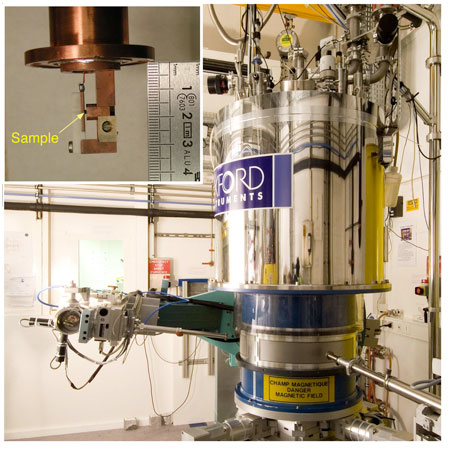- Home
- News
- General News
- Scientists observe...
Scientists observe smallest atomic displacements ever
01-09-2011
A breakthrough in understanding materials for next-generation electronic devices.
An international team of scientists has developed a novel X-ray technique for imaging atomic displacements in materials with unprecedented accuracy. They have applied their technique to determine how a recently discovered class of exotic materials – multiferroics – can be simultaneously both magnetically and electrically ordered. Multiferroics are candidate materials for new classes of electronic devices. The discovery, a major breakthrough in understanding multiferroics, is published in Science dated 2 September 2011.
The authors comprise scientists from the European Synchrotron Radiation Facility (ESRF) in Grenoble (France), the University of Oxford and the London Centre for Nanotechnology, University College London.
Everybody is familiar with the idea that magnets are polarised with a north and a south pole, which is understood to arise from the alignment of magnet moments carried by atoms in magnetic materials. Certain other materials, known as ferroelectrics, exhibit a similar effect for electrical polarisation. The exotic “multiferroic” materials combine both an ordered arrangement of atomic magnetic moments and ferroelectric polarisation, with a strong coupling between the two usually separate phenomena.
This leads to the strange effect that a magnetic field can electrically polarise the material, and an electric field magnetise it. Interest in multiferroics was ignited following the discovery in 2003 by Kimura and co-workers in Japan of a gigantic coupling between magnetism and ferroelectricity in a specific class of materials, opening up the possibility of harnessing such exotic properties for novel electronic devices. Proposals include a new type of electronic memory, in which an electric field writes data into the memory and a magnetic detector is used to read it. This process is faster, and uses less energy than today’s hard disk drives.
However, the origin of the electric polarisation in multiferroics has remained elusive until now. The team’s work unambiguously shows that the electric polarisation in the multiferroic studied proceeds from the relative displacement of charges of different signs, rather than the transfer of charge from one atom to another.
As the displacement involves a high number of electrons, even small distances can lead to significant electrical polarisation. The actual distance of the displacement still came as a surprise: about 20 femtometres, or about 1/100,000th of the distance between the atoms in the material. Measuring such small displacements was actually believed to be impossible.
“I think that everyone involved was surprised, if not staggered, by the result that we can now image the position of atoms with such accuracy. The work is testament, amongst other things, to the fantastic facilities available in Grenoble to the UK science community,” says Prof. Des McMorrow, Deputy Director of the London Centre for Nanotechnology, leader of the UCL part of the project.
Dr. Helen Walker, from the ESRF and lead author on the paper, developed with her colleagues a smart new experimental technique which exploits the interference between two competing processes: charge and magnetic scattering of a powerful, polarised X-ray beam. They studied a single crystal of TbMnO3 which shows a strong multiferroic coupling at temperatures below 30K (-243 degrees centigrade), and were able to measure the displacements of specific atoms within it with an accuracy approaching one femtometre (10-15 m). The atoms themselves are spaced apart 100,000 times this distance.
The new interference scattering technique has set a world record for accuracy in absolute measurements of atomic displacements. Most significantly, identification of the origin of ferroelectricty in a multiferroic material is a major step forward in our understanding of multiferroics which may in the long term lead to the design of multiferroics for practical applications.
"By revealing the driving mechanism behind multiferroics, which offer so many potential applications, it underlines how experiments designed to understand the fundamental physics of materials can have an impact on the wider world,” concludes Dr. Helen Walker.
Reference
H.C. Walker, F. Fabrizi, L. Paolasini, F. de Bergevin, J. Herrero-Martin, A.T. Boothroyd, D. Prabhakaran & D.F. McMorrow, Science 333, 1273-1276 (2011).
Top image: Femtoscale atomic displacements in multiferroics (Image courtesy of Ghiandoni and Paolasini).





